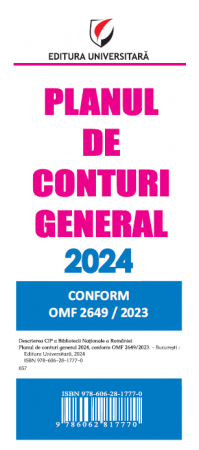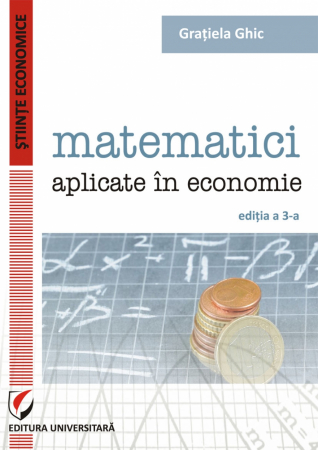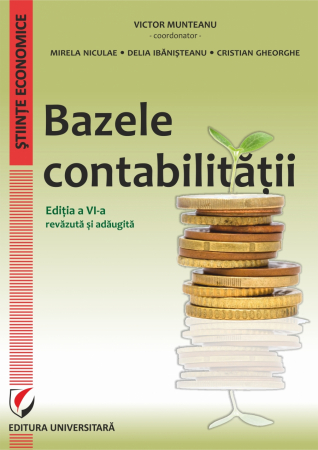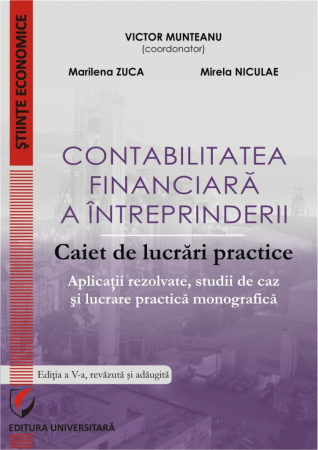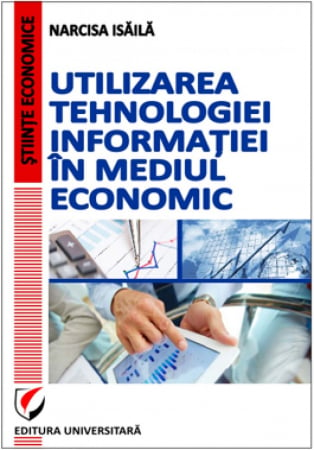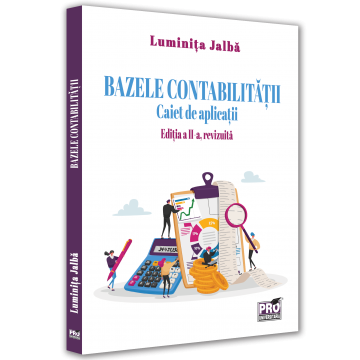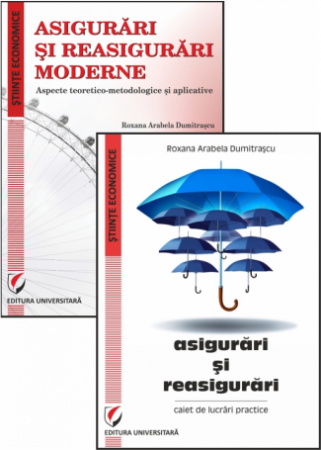Manuscript proposals: [email protected] / 0745 204 115 //// Tracking orders Individuals / Sales: 0745 200 357 / Orders Legal entities: 0721 722 783
Publisher: Editura Universitară
Author: Roxana Arabela Dumitrascu
ISBN: 978-606-591-960-0
DOI: 10.5682/ 9786065919600
Publisher year: 2014
Edition: I
Pages: 175
Product Code:
9786065919600
Do you need help?
0745 200 357
- Description
- Download (2)
- Authors
- Content
- More details
- Reviews (0)
The present paper aims to present a description of the insurance / reinsurance products and services starting from the conceptual premises mentioned above.
The paper is intended for all those interested in knowing the complexity of the offers formulated by modern insurance companies.
The paper is intended for all those interested in knowing the complexity of the offers formulated by modern insurance companies.
Education:
Faculty of Economics, University "Petre Andrei" of Iasi, specializing in Finance and Accounting (2001);
Post-graduate School of the University FIBAS "Al. I. Cuza" Iasi, master's degree in Economics and Financial Management & Banking (2005);
Academy of Economic Studies (2010), PhD in Finance;
Romanian Academy, SPODE, post-doctoral studies in economics.
Activity:
2001-2011 professor at the Faculty of Economics of the University "Petre Andrei" of Iasi;
2012 Ph.D. Lecturer at the Faculty of Finance, Banking and Accounting, of Christian University "Dimitrie Cantemir" of Bucharest, owner of enterprise financial management courses, insurance and reinsurance and risk management in insurance and reinsurance.
Publications:
Single author: Financial management company. Self-study manual (2012), Insurance and reinsurance. Self-study manual (2012), Prices and and competitivity. Self-study manual (2012), Management of the goodwill value (2008).
Coauthor: Intangible firm capital management (2009), Drift Management (2005), Management versus postmodernity (2005), Defiance complexity (2004), Elements of evaluating companies (2002).
Over 70 articles and studies published in scientific journals.
Insurance Products and Services
Introduction / 9
Chapter 1
Insurance market
1.1. General notions regarding the insurance market / 11
1.2. The impact of market segmentation on strategic insurance planning / 14
1.3. Insurance products / 17
1.4. Insurance - related services market / 21
1.5. Insurance market In the context of the knowledge economy / 23
1.6. Questions and tests / 27
Chapter 2
Market behaviors of insurance companies
2.1. Objectives and orientation of the insurance marketing activity / 29
2.2. Promotional activity on the insurance market / 31
2.3. Peculiarities of insurance consumer behavior / 34
2.4. Market strategies at the level of insurance / reinsurance companies / 35
2.5. Questions and tests / 38
Chapter 3
Property insurance - general considerations
3.1. General elements regarding goods insurance / 40
3.2. Substantiation of premium rates for goods insurance / 44
3.3. Questions and tests / 48
Chapter 4
Diversity of property insurance
4.1. Insurance of buildings, other constructions and their content Against damage caused by fire and other calamities / 50
4.2. Ensuring the construction works - assembly and the responsibility of the constructor / 56
4.3. Insurance of goods or values Against theft by burglary or robbery / 57
4.4. Compulsory home insurance versus optional home insurance
4.5. Questions and tests / 58
Chapter 5
General conditions regarding the optional personal insurances
5.1. Characteristics of personal insurance / 65
5.2. Presentation of the main types of life insurance / 68
5.3. Other personal insurance / 72
5.4. Insurance premium and mathematical reserve for life insurance / 74
5.5. Questions and tests / 78
Chapter 6
Actuarial models used to determine the size of insurance premiums and mathematical reserve
6.1. Survival insurance / 80
6.2. Death insurance / 88
6.3. Mixed life insurance / 93
6.4. Mathematical reserve / 97
6.5. Questions and tests / 100
Chapter 7
Liability insurance
7.1. General elements of civil liability insurance / 102
7.2. Compulsory motor third party liability insurance / 106
7.3. Professional civil liability insurance / 117
7.4. Employer, producer and manager civil liability insurance / 121
7.5. Goods insurance during transport / 123
7.6. Other types of civil liability insurance / 128
7.7. Questions and tests / 129
Chapter 8
Insurance of financial risks
8.1. General elements of financial risk insurance / 132
8.2. Credit insurance / 134
8.3. Guarantee insurance and fidelity insurance / 140
8.4. Questions and tests / 142
Chapter 9
National public social insurance system
9.1. General notions regarding the compulsory social insurances / 144
9.2. Questions and tests / 152
Chapter 10
Pensions
10.1. Public pension system and other social insurance rights / 154
10.2. Questions and tests / 160
Chapter 11
The national public system of health insurance and unemployment insurance
11.1. Social health insurance / 162
11.2. Unemployment insurance system / 165
11.3. Questions and tests / 168
General bibliography / 169
Annex / 173
Insurance services. Application works
PART 1
GOODS INSURANCE / 7
PART 2
ACTUARY MODELS USED TO DETERMINE THE SIZE OF INSURANCE PREMIUMS IN THE CASE OF LIFE INSURANCE / 19
PART 3
FIRST ANNUAL AND SUBANNUAL NETWORK FOR LIFE INSURANCE / 43
PART 4
OTHER TYPES OF INSURANCE / 50
Appendix
TABLE WITH SWITCH NUMBERS / 58
Introduction / 9
Chapter 1
Insurance market
1.1. General notions regarding the insurance market / 11
1.2. The impact of market segmentation on strategic insurance planning / 14
1.3. Insurance products / 17
1.4. Insurance - related services market / 21
1.5. Insurance market In the context of the knowledge economy / 23
1.6. Questions and tests / 27
Chapter 2
Market behaviors of insurance companies
2.1. Objectives and orientation of the insurance marketing activity / 29
2.2. Promotional activity on the insurance market / 31
2.3. Peculiarities of insurance consumer behavior / 34
2.4. Market strategies at the level of insurance / reinsurance companies / 35
2.5. Questions and tests / 38
Chapter 3
Property insurance - general considerations
3.1. General elements regarding goods insurance / 40
3.2. Substantiation of premium rates for goods insurance / 44
3.3. Questions and tests / 48
Chapter 4
Diversity of property insurance
4.1. Insurance of buildings, other constructions and their content Against damage caused by fire and other calamities / 50
4.2. Ensuring the construction works - assembly and the responsibility of the constructor / 56
4.3. Insurance of goods or values Against theft by burglary or robbery / 57
4.4. Compulsory home insurance versus optional home insurance
4.5. Questions and tests / 58
Chapter 5
General conditions regarding the optional personal insurances
5.1. Characteristics of personal insurance / 65
5.2. Presentation of the main types of life insurance / 68
5.3. Other personal insurance / 72
5.4. Insurance premium and mathematical reserve for life insurance / 74
5.5. Questions and tests / 78
Chapter 6
Actuarial models used to determine the size of insurance premiums and mathematical reserve
6.1. Survival insurance / 80
6.2. Death insurance / 88
6.3. Mixed life insurance / 93
6.4. Mathematical reserve / 97
6.5. Questions and tests / 100
Chapter 7
Liability insurance
7.1. General elements of civil liability insurance / 102
7.2. Compulsory motor third party liability insurance / 106
7.3. Professional civil liability insurance / 117
7.4. Employer, producer and manager civil liability insurance / 121
7.5. Goods insurance during transport / 123
7.6. Other types of civil liability insurance / 128
7.7. Questions and tests / 129
Chapter 8
Insurance of financial risks
8.1. General elements of financial risk insurance / 132
8.2. Credit insurance / 134
8.3. Guarantee insurance and fidelity insurance / 140
8.4. Questions and tests / 142
Chapter 9
National public social insurance system
9.1. General notions regarding the compulsory social insurances / 144
9.2. Questions and tests / 152
Chapter 10
Pensions
10.1. Public pension system and other social insurance rights / 154
10.2. Questions and tests / 160
Chapter 11
The national public system of health insurance and unemployment insurance
11.1. Social health insurance / 162
11.2. Unemployment insurance system / 165
11.3. Questions and tests / 168
General bibliography / 169
Annex / 173
Insurance services. Application works
PART 1
GOODS INSURANCE / 7
PART 2
ACTUARY MODELS USED TO DETERMINE THE SIZE OF INSURANCE PREMIUMS IN THE CASE OF LIFE INSURANCE / 19
PART 3
FIRST ANNUAL AND SUBANNUAL NETWORK FOR LIFE INSURANCE / 43
PART 4
OTHER TYPES OF INSURANCE / 50
Appendix
TABLE WITH SWITCH NUMBERS / 58
In recent decades, the insurance industry has become a major component of the financial services sector. From an activity somewhat subordinated to the evolutions registered on the real markets and adapted to their needs of limitation and absorption of operational and / or financial risks, the insurances have become, through the diversity of the offer, the complexity of the functional mechanisms, the sophistication of the contracting procedures. with other business areas, etc., one of the main development poles of the globalized financial economy.
The key function of insurance refers to the management of economic and social risks. A distinctive feature of modern socio-economic systems (individuals, companies, public institutions, economic and social sectors, localities, geographical areas, state and supranational formations, etc.) is the multiplication, diversification and amplification of the risks associated with their functioning. The proliferation of risks is the direct result of the increasing complexity of socio-economic systems, representing the expression of the increased vulnerability of these systems. The evolution of risks to higher levels of complexity has led to a reconsideration of risk management concepts and practices, especially the rethinking and redesign of financial mechanisms for their absorption.
The horizontal development (by launching new products and services) and the vertical one (by deepening the specialization and accentuating the fragmentation of the production chain of the economic value) developed in the insurance sector is a response to the increase of the variety of risks. In this order of ideas, the explosive diversification of the insurance companies' offer, by elaborating and launching on the market a huge number of products and services adapted to the most varied needs of the clients in terms of assumption and protection against risks, is presented as a structural change. and strategy that places insurance among the most innovative and dynamic business areas.
Continuing to assume the function of taking over, dissipating and managing risks, modern insurances have evolved towards extremely complex forms, which also integrate investment solutions and / or saving possibilities. In this way, many of the products and services offered by insurance companies involve not only options for safeguarding risks, but also a very wide range of tools for multiplying and profitable capitalization. Insurance companies have consequently become important centers of financial intermediation.
The present paper aims to present a description of the insurance / reinsurance products and services starting from the conceptual premises mentioned above. The paper is intended for all those interested in knowing the complexity of the offers made by modern insurance companies.
Assoc. Dr. Roxana Arabela Dumitrascu
The key function of insurance refers to the management of economic and social risks. A distinctive feature of modern socio-economic systems (individuals, companies, public institutions, economic and social sectors, localities, geographical areas, state and supranational formations, etc.) is the multiplication, diversification and amplification of the risks associated with their functioning. The proliferation of risks is the direct result of the increasing complexity of socio-economic systems, representing the expression of the increased vulnerability of these systems. The evolution of risks to higher levels of complexity has led to a reconsideration of risk management concepts and practices, especially the rethinking and redesign of financial mechanisms for their absorption.
The horizontal development (by launching new products and services) and the vertical one (by deepening the specialization and accentuating the fragmentation of the production chain of the economic value) developed in the insurance sector is a response to the increase of the variety of risks. In this order of ideas, the explosive diversification of the insurance companies' offer, by elaborating and launching on the market a huge number of products and services adapted to the most varied needs of the clients in terms of assumption and protection against risks, is presented as a structural change. and strategy that places insurance among the most innovative and dynamic business areas.
Continuing to assume the function of taking over, dissipating and managing risks, modern insurances have evolved towards extremely complex forms, which also integrate investment solutions and / or saving possibilities. In this way, many of the products and services offered by insurance companies involve not only options for safeguarding risks, but also a very wide range of tools for multiplying and profitable capitalization. Insurance companies have consequently become important centers of financial intermediation.
The present paper aims to present a description of the insurance / reinsurance products and services starting from the conceptual premises mentioned above. The paper is intended for all those interested in knowing the complexity of the offers made by modern insurance companies.
Assoc. Dr. Roxana Arabela Dumitrascu
If you want to express your opinion about this product you can add a review.
write a review

6359.png)
![Set: Insurance Products and Services + Insurance Services. Application Works [1] Set: Insurance Products and Services + Insurance Services. Application Works [1]](https://gomagcdn.ro/domains/editurauniversitara.ro/files/product/large/set-insurance-products-and-services-insurance-services-application-works-1018-5231.jpg)
